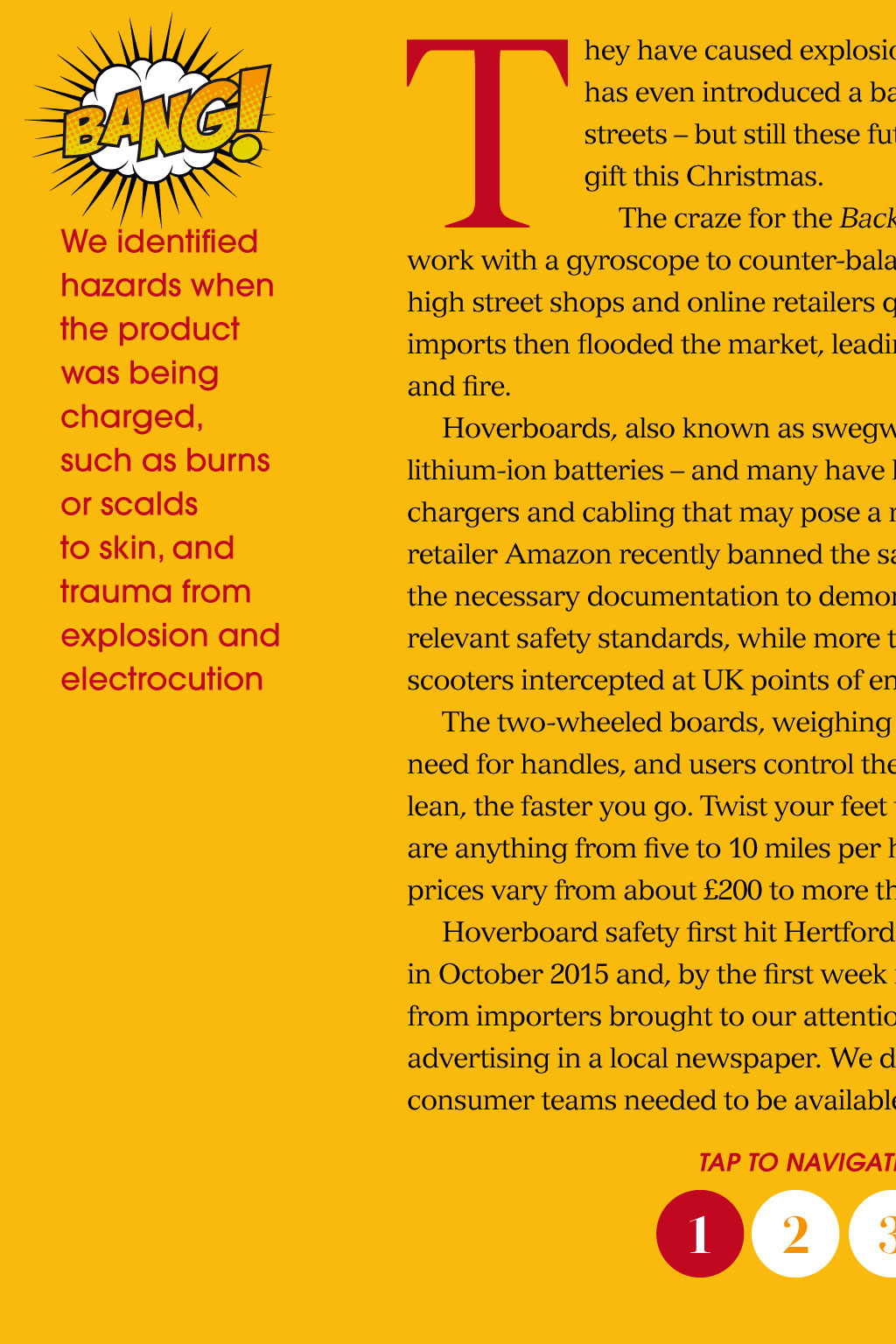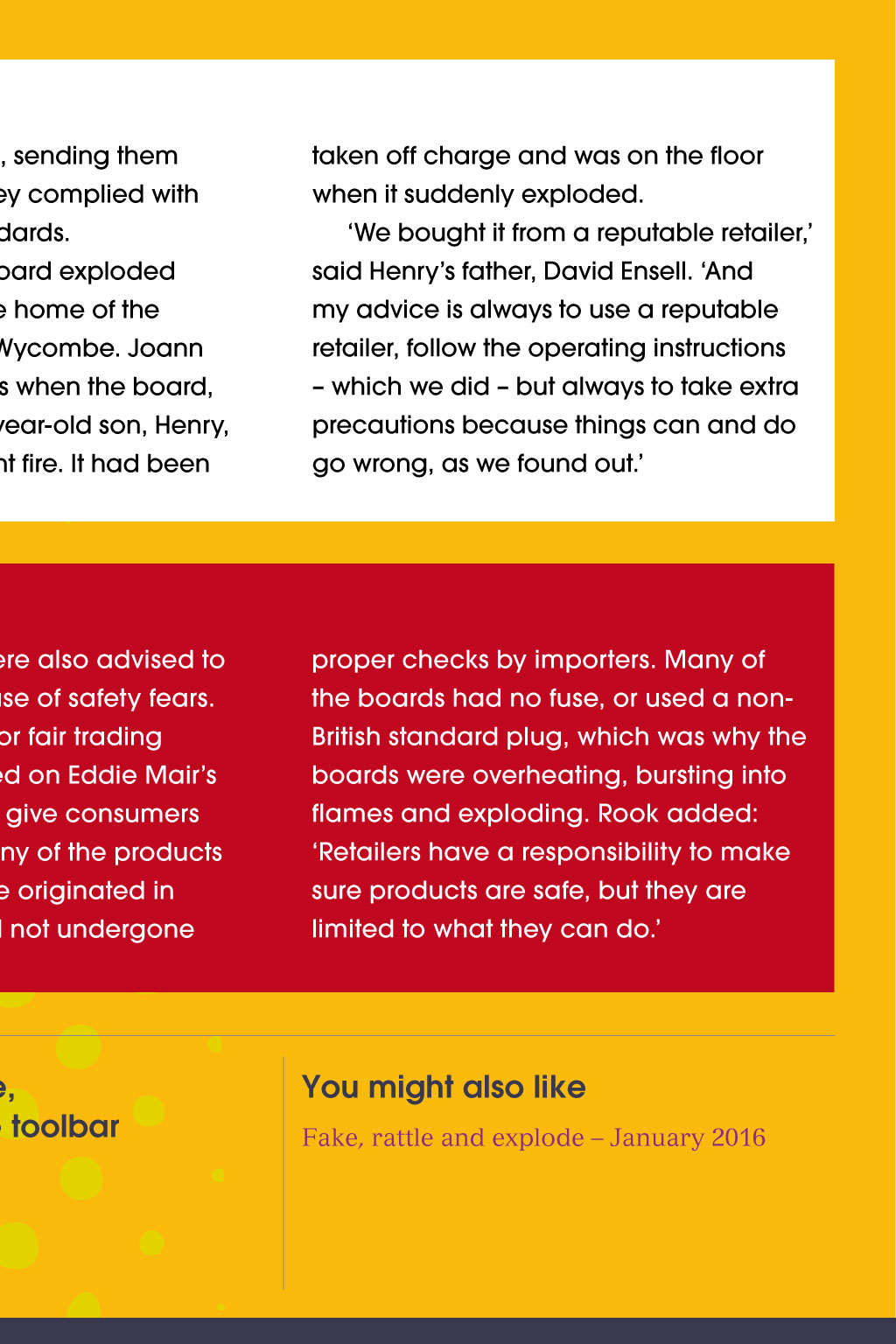
















They have caused explosions and fires, and New York City has even introduced a ban on hoverboards being used on its streets – but still these futuristic toys were children’s must-have gift this Christmas. The craze for the Back To The Future-like boards – which work with a gyroscope to counter-balance the user’s weight – meant that high street shops and online retailers quickly sold out. Cheap, dangerous imports then flooded the market, leading to serious risks of explosion and fire. Hoverboards, also known as swegways and eboards, are powered by lithium-ion batteries – and many have been sold with non-compliant plugs, chargers and cabling that may pose a risk of electric shock and fire. Online retailer Amazon recently banned the sale of hoverboards that didn’t have the necessary documentation to demonstrate they were compliant with relevant safety standards, while more than 15,000 of the 17,000 self-balancing scooters intercepted at UK points of entry have been detained at the border. The two-wheeled boards, weighing about 10kg each, work without the need for handles, and users control the speed of the wheels. The more you lean, the faster you go. Twist your feet to turn; lean back to brake. Top speeds are anything from five to 10 miles per hour, depending on the brand, while prices vary from about £200 to more than £1,000. Hoverboard safety first hit Hertfordshire Trading Standards’ radar in October 2015 and, by the first week in December, our queries ranged from importers brought to our attention by ports and borders, to retailers advertising in a local newspaper. We decided that our business advice and consumer teams needed to be available to deal with any type of request. Unsafe products In this feature l hoverboards l fire risk l regulations Credits Judith Gordon is principal trading standards officer at Hertfordshire Trading Standards. Images: Jonathan Lingel / Shutterstock To share this page, click on in the toolbar You might also like Fake, rattle and explode – January 2016 The hip new two-wheeled hoverboarding craze became the nightmare before Christmas for trading standards, as cheap fakes flooded the market, causing fires and explosions. Judith Gordon recounts events The big We identified hazards when the product was being charged, such as burns or scalds to skin, and trauma from explosion and electrocution Stories from around the UK n London Fire Brigade reported that two men had to escape through a first-floor window from a fire at a house in Morden, after a banging noise alerted them to a blaze in a room where a hoverboard had been charging. n Buckinghamshire and Surrey Trading Standards intercepted a £7,000 consignment of 51 self-balancing boards imported from China, sending them for testing to see if they complied with electrical safety standards. n A self-balancing board exploded and caught fire in the home of the Ensell family in High Wycombe. Joann Ensell sustained burns when the board, belonging to her 10-year-old son, Henry, exploded and caught fire. It had been taken off charge and was on the floor when it suddenly exploded. ‘We bought it from a reputable retailer,’ said Henry’s father, David Ensell. ‘And my advice is always to use a reputable retailer, follow the operating instructions – which we did – but always to take extra precautions because things can and do go wrong, as we found out.’ hoverboards in numbers Making headlines Concerns about hoverboards hit the headlines in the run-up to Christmas, leading to major retailers withdrawing stocks from sale. At the height of the controversy, online trader Amazon – and high street giants John Lewis and Argos – withdrew certain types of hoverboard from their shops. Customers were also advised to return boards because of safety fears. CTSI lead officer for fair trading Sylvia Rook appeared on Eddie Mair’s BBC Radio 4 show to give consumers advice. She said many of the products were thought to have originated in the Far East and had not undergone proper checks by importers. Many of the boards had no fuse, or used a non- British standard plug, which was why the boards were overheating, bursting into flames and exploding. Rook added: ‘Retailers have a responsibility to make sure products are safe, but they are limited to what they can do.’ For this to work, all colleagues needed to be informed; two documents in particular – Intelligence Analysis, produced by Trading Standards North West, and the Product Safety Alert, by the National Trading Standards Single Point of Contact team at Suffolk – helped in the early stages. For an importer (and others whose actions may affect a product’s safety), the producer responsibilities under the General Product Safety Regulations 2005 apply; distributor responsibilities apply to all others. The Plugs and Sockets etc. (Safety) Regulations 1994 and the Electrical Equipment (Safety) Regulations apply throughout the supply chain. Other potentially relevant law includes the Supply of Machinery (Safety) Regulations 2008 (for the moving parts), the Radio Equipment and Telecommunications Terminal Equipment Regulation 2000 (if the board includes Bluetooth) and the Toys (Safety) Regulations 2011 (if the board is marketed as a toy). Where further provision and officer powers are needed, Regulation (EC) 765/2008 requirements for market surveillance specify general measures and a framework for consumer safety, to use where provisions are not found elsewhere. Actions include ensuring products are withdrawn, prohibited or restricted. Our authority’s experiences mirrored those of officers at UK ports and borders. We found safety issues with the plug, cabling, charger, battery or the cut-off switch within the board, which often fails. Many of the items seized were found to have non-compliant plugs without fuses, which also increases the risk of the device overheating, exploding or catching fire. We identified hazards when the product was being charged, such as burns or scalds to skin, and trauma from explosion and electric shock. The type of consumer was identified as vulnerable – aged eight to 14 years – and the scenario risks ranged from medium through high, to serious. We used the RAPEX risk assessment tool and the PROSAFE Consumer Product Safety in Europe Corrective Action Guide. A decision was taken in early November to devise a strategy for handling issues. A hoverboard ‘lead’ was appointed. A separate officer dealt with any primary authority companies who had – or were thinking of – importing. Our trader database was scrutinised, as was ‘open source’ for potential suppliers. Business advice was drafted. Consumer advice took the format of a press release and tweets, and volunteers visited public and private markets to identify whether the products were on sale. Hertfordshire Trading Standards is part of a wider community protection directorate at Hertfordshire County Council, which includes our fire and rescue service. All fire investigators were notified of the safety issues, as were station crews. Whatever happened to onesies being the must-have gift for Christmas? Generating interest We had already planned to exhibit at the Electrical Safety First’s (ESF) annual conference in November, so we took a hoverboard seized in Hertfordshire with us, as well as photos taken by a neighbouring authority of a fire caused by a hoverboard. There was a lot of interest in the product, and it proved a good opportunity to discuss and share information with other delegates. ESF assisted us with screening tests at a point when test houses were at capacity. The ESF plug gauges were a very useful screening tool that could be used ‘in the field’, helping to determine at first glance whether the fitted plug – one of the main causes of failure – complied. During our busiest period, a decision was made to prioritise our work with importers and distributors. Each situation was considered individually. Clearly, establishing a dialogue was key and identifying the location of stock – and number of units – was paramount. Officers made the necessary enquiries about technical files and compliance. We ensured we acted in a manner appropriate to the seriousness of the risk and took account of the precautionary principle. Voluntary action – including suspension – was specifically encouraged and promoted as an alternative to formal enforcement. Nevertheless, we were prepared, if necessary, to take urgent action against those products posing a serious risk. Media interest started with a press release through our communications team and led to requests for radio interviews, just ahead of the National Trading Standards press release of 3 December 2015. The two most important messages we wanted to give, post-purchase, to consumers was not to charge the product overnight, and not to leave it unattended while charging. For consumers who were looking for a board to buy, we wanted to make them aware of historical fires and explosions, and that we’d discovered a number of safety issues. Our advice was accompanied by a reminder that hoverboards are not for use on roads and pavements. At the same time, we composed several tweets, each with a slightly different message. For instance, Reqs the Fire Dog, a black labrador that helps Herts fire and rescue investigate fires, as well as promote safety messages. His Twitter account has more than 4,000 followers and we used it to send out tweets, and to retweet hoverboard media articles. n 88 per cent of boards sampled have failed safety testing n 17,000 have been seized at UK ports of entry n Prices vary from £200 to more than £1,000 n Trading standards officers in Salford, Greater Manchester, seized 90 hoverboards in November n Hoverboards have been banned in New York City – someone caught riding one in public could be subject to a $200 fine n Macy’s famous Manhattan flagship store gave more than 20ft of retail space to the futuristic boards hoverboards in numbers